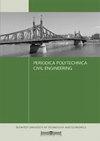Locating Method for Pick-up and Drop-off Spots for Shared Autonomous Vehicle-based Mobility Services
IF 1.4
4区 工程技术
Q3 ENGINEERING, CIVIL
引用次数: 0
Abstract
To provide safety to users and not disturb traffic flow, autonomous vehicles in shared on-demand mobility services cannot stop everywhere; thus, pick-up and drop-off (PUDO) spots must be dedicated or established for them. Our research objective is to propose a method to locate the PUDO spots for shared autonomous vehicle-based mobility services as this topic has been barely studied. The number of required PUDO spots is calculated, and the location is chosen considering the urban environment, walking radius, vehicle occupancy, and time for boarding and alighting among other parameters. Different from some methods applied to shared mobility, we consider the existing infrastructure (e.g., parking spaces) as potential locations for PUDO spots. The method is applied to a study case, demonstrating the applicability and providing the main findings: (i) the required number of PUDO spots decreases if willingness to walk increases; (ii) with a 3-min walking radius, 83% of curbside parking spaces can be repurposed, and 100% is reached with a 10-min walking radius; (iii) the minimum of 55% of curbside parking spaces can be repurposed with 10-min walking radius and without locating PUDO spots in private parking. Using our method, cities can determine the quantity of PUDO spots and their locations, being prepared in advance for the required changes in the existing infrastructure as well as the freed-up space to be repurposed.基于共享自动驾驶汽车的出行服务上下车点定位方法
为了给用户提供安全保障,不干扰交通流量,按需共享出行服务中的自动驾驶汽车不能到处停车;因此,必须为他们设立专门的接送点。我们的研究目标是提出一种基于共享自动驾驶汽车的出行服务PUDO点的定位方法,因为这一主题的研究很少。计算所需PUDO点的数量,并根据城市环境、步行半径、车辆占用率、上下车时间等参数选择PUDO点的位置。与一些应用于共享出行的方法不同,我们考虑现有的基础设施(如停车位)作为PUDO点的潜在位置。将该方法应用于一个研究案例,证明了该方法的适用性,并提供了主要发现:(1)步行意愿增加,所需的PUDO点数量减少;(ii)在3分钟步行半径范围内,83%的路边停车位可重新利用;在10分钟步行半径范围内,可重新利用的路边停车位达到100%;(iii)不少于55%的路边泊车位可在10分钟步行半径内作其他用途,而无须在私人泊车位内设泊车位。使用我们的方法,城市可以确定PUDO点的数量和位置,提前为现有基础设施的必要变化以及重新利用的空闲空间做好准备。
本文章由计算机程序翻译,如有差异,请以英文原文为准。
求助全文
约1分钟内获得全文
求助全文
来源期刊

Periodica Polytechnica-Civil Engineering
工程技术-工程:土木
CiteScore
3.40
自引率
16.70%
发文量
89
审稿时长
12 months
期刊介绍:
Periodica Polytechnica Civil Engineering is a peer reviewed scientific journal published by the Faculty of Civil Engineering of the Budapest University of Technology and Economics. It was founded in 1957. Publication frequency: quarterly.
Periodica Polytechnica Civil Engineering publishes both research and application oriented papers, in the area of civil engineering.
The main scope of the journal is to publish original research articles in the wide field of civil engineering, including geodesy and surveying, construction materials and engineering geology, photogrammetry and geoinformatics, geotechnics, structural engineering, architectural engineering, structural mechanics, highway and railway engineering, hydraulic and water resources engineering, sanitary and environmental engineering, engineering optimisation and history of civil engineering. The journal is abstracted by several international databases, see the main page.
 求助内容:
求助内容: 应助结果提醒方式:
应助结果提醒方式:


